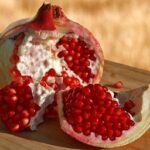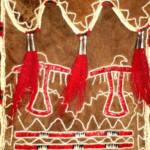The first settlers who crossed the Applachian Mountains into the fertile Ohio and Mississippi valleys found a beautiful amber-colored fruit growing wild in the fields and in lightly wooded areas–the native American persimmon. Native Americans taught the settlers how to combine the sweet, spicy pulp of the persimmon with cornmeal and honey to make simple dishes.
The persimmon is a round-shaped fruit the size of a quarter and some attain the size of a half dollar. They grow on trees as far north as Connecticut, southward into the Cotton Belt, and occasionally as far west as Kansas. They ripen in the mid-autumn(although some varieties do not ripen until late autumn) and never should be picked from the tree but allowed to ripen and fall to the ground, before they are harvested. The pulp can be made into puddings, breads, cakes, pies, cookies, sauces and much more.
Persimmon cookery has reached a high art among inhabitants of “persimmon country.” In particular, persimmon pudding has become a traditional Thanksgiving and/or Christmas dessert in the Midwest. Cooks in this region have vied with each other for generations in concocting new and exciting persimmon dishes.
Recipes vary from the simplest types of puddings with a few spices to those rich with raisins, fruit juices or cidar, molasses or honey, eggs whites, gelatin or whipped cream. Some persimmon desserts are more dry and crusty, while others are moist and heavy.
The flavor of persimmon pudding ripens with time, enabling the cook to seam or bake their puddings or desserts well before the holiday season.
As previously mentioned, persimmons should always be picked from the ground beneath the tree, after they have ripened and fallen. They should never be shaken or plucked from the tree but allowed to ripen and fall in nature’s own good time. Unripened persimmons are puckery and can ruin the taste of your recipe. At maturity they are fairly soft and some do not survive the fall from the tree. They should be carefully picked up as soon after they’ve fallen as possible.
Persimmons should be rinsed in cold water immediately, then placed on paper towels to dry, finally refrigerated as soon as possible. They spoil easily in heat. They can be stored whole in the refrigerator for 24 hours but should be processed thereafter. Some people freeze their persimmons immediately after harvesting, then wash them in their frozen state. If you use this method, you shouldn’t refreeze the pulp after processing.
After the cleaning, begin processing them by first removing the tiny black stem on the bottom with a knife or with your thumb and index finger. The fruit is ready to put through the collander. Work the persimmon through the collander, leaving their skins and flat dark seeds as residue. In your bowl, you will have a luscious-looking mound of pulp the color of yams or ripe pumpkin. Pour the pulp into plastic pint containers for freezing or later use. Because most recipes call for 1-2 cups of pulp, the pint container is a convenient storage vessel. Pulp can be stored in a frozen state for up to a year. Here’s a recipe for your persimmons:
Walnut Persimmon Pudding
2 cups flour
1 cup sugar
2 tsp. baking powder
1/2 tsp. baking soda
1 tsp. cinnamon
3/4 cup sweet milk
1/2 cup chopped walnuts
1/2 cup raisins
2 eggs
1 cup persimmon pulp
1/2 cup melted butter
1 tsp. vanilla
Sift dry ingredients together, then add nuts and raisins. Beat eggs, add to pulp. Then add butter, milk and vanilla. Combine pulp mixture with the dry ingredients. Stir well. Pour into a greased 13 by 9 inch pan and bake for 45 minutes at 325. Serve with ice cream or whipped cream.



